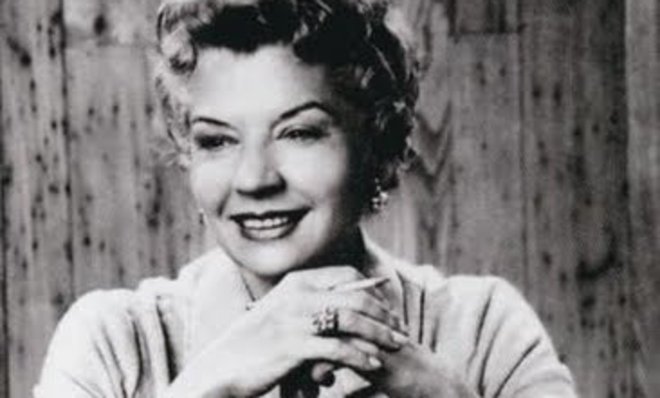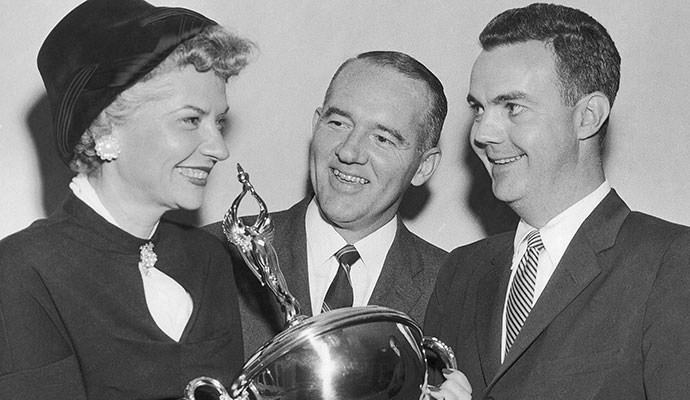The queen of Tupperware
Single mom Brownie Wise helped build a plastics empire — one house party at a time

ON AN UNSEASONABLY warm day in April 1954, hundreds of women in cowboy hats gathered outside Tupperware's Florida headquarters to dig for buried treasure. It was the pinnacle of the inaugural Tupperware Jubilee, a five-day, gold-rush-themed affair celebrating all things Tupperware.
For five hours that day, the women, a collection of dealers, distributors, and sales managers, prospected for mink stoles and freezer units, gold watches and diamond rings. One of them, Fay Maccalupo of Buffalo, dug up a toy car. When she saw the real Ford it represented, she planted her face against the hood and began to weep, repeating, "I love everybody."
Presiding over the treasure hunt was the general sales manager of the Tupperware Home Parties division, a 40-year-old woman named Brownie Wise. For hours, she cheered on the ladies from a loudspeaker with an air of royalty. As she watched them hop on shovels and unearth the rewards of their labors, she couldn't help feeling proud.
The Week
Escape your echo chamber. Get the facts behind the news, plus analysis from multiple perspectives.

Sign up for The Week's Free Newsletters
From our morning news briefing to a weekly Good News Newsletter, get the best of The Week delivered directly to your inbox.
From our morning news briefing to a weekly Good News Newsletter, get the best of The Week delivered directly to your inbox.
The story of the ubiquitous plastic container is a story of innovation and reinvention: how a new kind of plastic, made from an industrial waste material, ended up a symbol of female empowerment. The product ushered women into the workforce, encouraging them to make their own money, better their families, and win accolades and prizes without fear of being branded that 1950s anathema, "the career woman." And all of it was because of Wise.
NAMED FOR HER big, brown eyes, Brownie Wise was born in rural Georgia. Her parents divorced when she was young, and as a teen she traveled with her mother, who organized union rallies. Wise started giving speeches at her mother's rallies and proved to be a gifted and motivating orator. She "awed people," writes Bob Kealing in his biography Tupperware Unsealed.
Wise was married briefly, but by 27, she was a divorced single mom in suburban Detroit. During World War II, she worked as a secretary at Bendix Aviation, a company that made parts for Navy torpedo planes. It was a decent but unfulfilling job. What Wise did possess was an endless fountain of determination. As she wrote in a journal at that time, "I wanted to be a successful human being."
It all started with a bad door-to-door salesman. When a Stanley Home Products salesman knocked on her door and proceeded to deliver a terrible sales pitch for cleaning supplies, Wise scoffed that she could do better. At the time, Stanley was experimenting with a peculiar sales model: home parties. A New Hampshire mop salesman had watched his numbers fly through the roof after he invited a bunch of women over for a party that included a mop demonstration. The company encouraged other salesmen to try the strategy, but many of them delegated the hosting to their wives. Thinking it'd be a fun side job, Wise started selling Stanley products at parties, too. Before long, she was making enough money to quit her job at Bendix.
A free daily email with the biggest news stories of the day – and the best features from TheWeek.com
Wise first glimpsed Tupperware at a sales meeting. One of her co-workers had seen the products gathering dust in a department store and decided to bring them in. At first, Wise didn't think they were anything special. But when she accidentally knocked a Tupperware bowl off the table, she realized its full potential: Instead of breaking, it bounced.
It seemed like magic. Tupperware was unlike any home product she'd seen. It was attractive, coming in pastel colors and flexible shapes, almost like art. More important, it was functional — no other competing product even came close. Convinced of its potential, Wise traded in her Stanley brooms in 1949 and started throwing parties to sell Tupperware. What she didn't intend, exactly, was to kindle a revolution.
THE MOST AMAZING thing about Tupperware wasn't that it extended the life of leftovers and a family's budget, although it did both remarkably well. It was, above all, a career maker. Wise was such a charming host that she persuaded many buyers to also become Tupperware salespeople. And the more parties Wise hosted, the more tricks she learned to convert women into Tupperware faithful. Putting people on waiting lists, for instance, made them more eager to buy. She also discovered that throwing containers full of liquid across the room made customers reach straight for their checkbooks.
By October 1949, she had 19 recruits, enough to move her supplies out of her house and into a larger warehouse. Wise's team in Detroit was selling more Tupperware than most department stores. This soon attracted the attention of the no-nonsense founder of the Tupperware Corporation, Earl Silas Tupper.
Tupperware, true to its name, was Tupper's masterpiece, and he was counting on it to make his dreams come true. Having grown up in a poor Massachusetts farm family, he had vowed to make a million dollars by the time he was 30. He hadn't. He did have a host of esoteric inventions — among them, a fish-powered boat and a no-drip ice cream cone — under his belt. But with a wife and family to support, he'd concentrated on a practical career in plastics, first at DuPont and then at a company of his own, which made parts for Jeeps and gas masks during World War II. When the war ended, Tupper decided to buy cheap surpluses left over from wartime manufacturing. He figured he'd be able to do something with them.
That's how he ended up with a glob of greasy black polyethylene, a smelly waste product left behind when metal is created from ore. Tupper took it and, after months of trial and error, wrangled the slag into submission, creating a lightweight plastic that refused to break. Tupper dubbed it Poly-T, and, taking inspiration from the way paint cans sealed, created a flexible container with a noiseless lid that snapped on. He called the box Tupperware. The only problem? He couldn't get anyone to buy it.

At least not until Wise came along. Her sales record was remarkable — in 1949, she'd rung up $150,000 in orders and was offered a promotion: distribution rights to the entire state of Florida. In the spring of 1950, she moved south with her son, Jerry, and her mother. She found a store space, and by May she'd opened her business and was scouting for new salespeople.
Still, not everything was going smoothly. Along with disputes over turf with other distributors, she was constantly contending with botched orders, shipping delays, and product shortages. In March of 1951, Wise had had enough. She called Tupper in a fury. It was the first time they'd spoken, but she was too livid for niceties; she ripped into him immediately. This was hurting not just her bottom line but also his. Did he not understand how crucial it was that the problems be fixed immediately? Tupper assured her that he'd fix any issues and then asked a favor: He wanted to hear her sales secrets.
The next month, the two met at a conference on New York's Long Island, and Wise explained her selling technique. It was pointless, she explained, to think that people would see Tupperware on store shelves or in catalogs and want to buy it. Instead, people had to touch it, squeeze it, drop it, seal it. She gave a bold prescription for saving Tupper's business: Ditch department stores altogether and focus entirely on throwing home parties.
Tupper took the advice to heart. So much, in fact, that the day after their meeting, he created a new division just for home parties and asked Wise to be the general manager.
IN 1952, THE first full year of Wise's watch, Tupperware sales rocketed. Wholesale orders exceeded $2 million. During the last half of the year, sales tripled. Tupperware parties did exactly what Wise promised they would, and she became the company's shining star. That year, Tupper gave her a salary of $20,933.33, more than she had ever made. For her birthday in 1953, he presented her with a gold-dyed palomino horse. Even more remarkably, he gave her the freedom to do practically whatever she wanted. So Wise traveled the country recruiting, presiding over sales conferences, and announcing contests and doling out prizes for incentive.
By the looks of it, most of Wise's Tupperware recruits fit neatly into the stereotypical role of a proper housewife. But, in reality, they surreptitiously represented a new kind of female empowerment. During World War II, many women had no choice but to enter the workforce. At its end, many of them had no choice but to leave it. Suddenly, selling Tupperware at parties allowed women to straddle both worlds. They were employed, yet they didn't appear to challenge their husbands' authority or the status quo.
The parties were also a way they could contribute to their family's bottom line. The money — committed dealers could bring in $100 or more per week — was a revelation. The opportunity for success was so great that the husbands of some Tupperware ladies left their own jobs to work with their wives.
As Wise became the face of Tupperware, sales and press continued to skyrocket. In 1954, she was the first woman to appear on the cover of Business Week. But as glowing as the magazine's profile was, it contained warning signs about the future of her partnership with Tupper. The piece credited Wise and her sales technique with Tupperware's estimated $25 million in retail sales and seemed to downplay Tupper's role as president of the company he had created.
Tupper had never craved the spotlight; in fact, he was known to use the back door of his office to avoid attracting attention. But he was keen to ensure that his product, not an employee, received the lion's share of any attention.
The good press continued but, in 1955, after several powerful distributors left the company, sales began to lag. Hard times strained Wise and Tupper's relationship. By 1956, angry letters were flying back and forth between them, and at one point, Tupper stopped taking Wise's calls. Her complaints and frank criticisms, previously helpful, had become jabs he couldn't endure. He also started to believe that she was costing him money, irked that she had her own side business selling self-help books at company events. More to the point, he started to suspect that if he tried selling the company — which he was planning to do — having a female executive would get in the way.
Finally, in 1958, Tupper flew to Florida and fired Wise. After a heated legal battle, she received only $30,000 as a settlement. She didn't own her house and was ordered to vacate. She had no stock in the company; she didn't even own many of the clothes she wore. The man she'd helped make a millionaire didn't seem to care: Tupper ordered her name expunged from the company history and buried the 600 remaining copies of her book in an unmarked pit behind Tupperware's Florida headquarters. Later that year, he sold the company to Rexall Drug for $16 million, divorced his wife, and bought an island in Central America. He died in Costa Rica in 1983. Wise, on the other hand, tried starting new companies but never achieved the same success she had with Tupperware. She led a quiet life with her horses, pottery, and her son until she died at her home in Kissimmee in 1992.
Her influence, however, has not waned. Today, Tupperware is sold in about 100 countries, and every 2.5 seconds, a Tupperware party is held somewhere in the world.
Excerpted from an article that originally appeared in Mental Floss. Reprinted with permission.
-
 The Trump administration says it deports dangerous criminals. ICE data tells a different story.
The Trump administration says it deports dangerous criminals. ICE data tells a different story.IN THE SPOTLIGHT Arrest data points to an inconvenient truth for the White House’s primary justification for its ongoing deportation agenda
-
 Ex-FBI agents sue Patel over protest firing
Ex-FBI agents sue Patel over protest firingspeed read The former FBI agents were fired for kneeling during a 2020 racial justice protest for ‘apolitical tactical reasons’
-
 The real tragedy that inspired ‘Hamlet,’ the life of a pingpong prodigy and the third ‘Avatar’ adventure in December movies
The real tragedy that inspired ‘Hamlet,’ the life of a pingpong prodigy and the third ‘Avatar’ adventure in December moviesThe Week Recommends This month’s new releases include ‘Hamnet,’ ‘Marty Supreme’ and ‘Avatar: Fire and Ash’